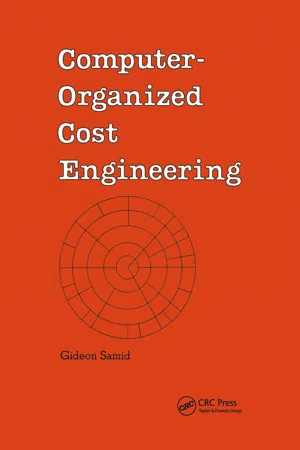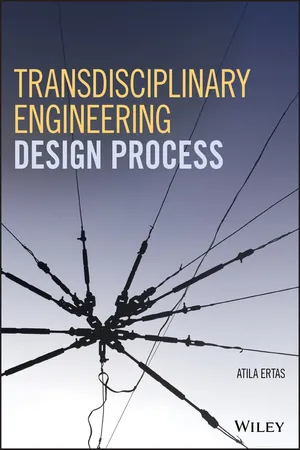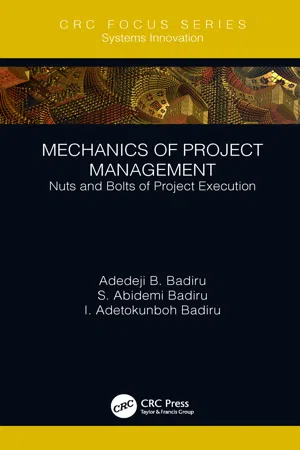Technology & Engineering
Elements of Cost
The elements of cost refer to the various components that contribute to the total cost of producing a product or delivering a service. These elements typically include direct materials, direct labor, and manufacturing overhead. Understanding and analyzing these cost elements is essential for effective cost management and decision-making within a business or organization.
Written by Perlego with AI-assistance
Related key terms
5 Key excerpts on "Elements of Cost"
- eBook - ePub
- Gideon Samid(Author)
- 2020(Publication Date)
- CRC Press(Publisher)
Computers gave the cost engineer a tool that added a new dimension to the profession. The use of computers in itself is an engineering endeavor, and so today the term “(cost) engineering” has a dual meaning: expertise not only in the subject matter but also in using computers in the process of optimizing resource allocation. The modern cost engineer is a central player in a competitive economy. His or her responsibility is to find ways to extract more results from finite dollars and limited time. And, conversely, he or she tries to engineer a solution to the problem of achieving a target result with a smaller investment.Available resources are finite; expressive imagination is infinite. This anomaly is the challenge of cost engineering.Passage contains an image
1Elements
Cost engineering is a two-way window. Looking through this window the business community relates to science and technology. Looking the other way, scientists and engineers hear and see what business wants and does.Cost engineering answers questions: How much does it cost? How long will it take? And later, Does it really cost and take as much and as long as predicted? The cost engineering components that handle these questions are cost estimation, scheduling, and cost control, the Elements of Cost engineering.1The difficulty or simplicity of handling these questions depends on (1) the complexity of the subject matter, (2) the prevailing constraints, (3) the extent to which 1 and 2 are given or known. (1) - eBook - ePub
- Atila Ertas(Author)
- 2018(Publication Date)
- Wiley(Publisher)
The engineering estimate. An engineering estimate is made up of the individual costs of many elements of the design at a low level of detail. The estimate includes costs for every element of the design and fabrication process, including the cost of production tools, jigs, and fixtures. Components, lengths of piping and tubing, the number and size of welds, the quantities and types of materials, surface treatments, test requirements, and the like, are identified from the engineering drawings and are multiplied by the element unit cost that may come from vendors, or from production and in-house cost standards. Element costs are determined for each of these elements at the lowest reasonable level of detail. Some elements of the overall cost, such as inspection and production control, are estimated by taking a percentage of direct labor, which invariably results in uncertainty in the final estimate. The overall estimate is made by summing all these individual element costs.There are two basic drawbacks to the use of engineering estimates – the time required to prepare the estimate and the difficulty in seeing the forest and not just the trees. When a cost estimate is made up of many individual cost elements, it is difficult to keep an overall perspective and not get lost in all the detail. When this cost estimating technique is used it is often augmented by the use of other (more gross) techniques to ensure that the overall estimate is valid. Engineering estimates are often used in construction projects, especially when field changes are being negotiated.Estimating by use of analogy - eBook - ePub
- Thomas J. Day(Author)
- 2022(Publication Date)
- CRC Press(Publisher)
195 to sum up and calculate what is referred to as Life Cycle Costs. All three have to be considered together when performing a Cost/Benefit Analysis. All three components are necessary to be consider when determining the life cycle of a technology. They are defined as:Capital Costs: The expenditure of resources required to obtain, install, startup and transition technology to a Technology Management Team. This includes consulting engineers, startup and installation parts and supplies, and all unique labor resources required to bring the technology to full operation.Financing Costs: Those expenditures necessary to pay for the borrowing of money to pay for any Capital Costs.Operations/Maintenance Costs: The expenditure of resources to use the technology on a day-to-day basis, including its upkeep including repairs, parts, unique labor services and the systems to monitor and report technology health.Life Cycle Costs: The total of all costs to acquire, install, operate, and maintain the technology.The actual Capital Costs are generally well understood but seldom tabulated correctly. Technology Teams tend to believe that the only costs associated with Capital Costs are the bid or price of acquisition. As a result, when technology managers develop engineering estimates, the full breath of Capital Costs are ignored and the Team runs short of funds during the Program/Project execution. It is important to consider these costs during an engineering estimate at the beginning so they are all included, or at least addressed.Financing Costs are incurred when the management or oversight team borrows funds to acquire the technology. Depending on the type of technology being acquired, this could be a small or large amount, and are subject to unique tax considerations again depending on the type of technology, and the country in which the installation occurs. Many technologies have controls both at the country of origin and the country acquiring. These all affect the rate and amount of financing and are unique to each situation. It is therefore important to have a savvy tax accountant review especially large or uniquely capitalized investments to ascertain the Financing Costs for estimates. - eBook - ePub
Mechanics of Project Management
Nuts and Bolts of Project Execution
- Adedeji B. Badiru, S. Abidemi Badiru, I. Adetokunboh Badiru(Authors)
- 2018(Publication Date)
- CRC Press(Publisher)
12. Establish criteria for phasing out a project when it is no longer serving the desired purpose. Project Cost ElementsCost management in a project environment refers to the functions required to maintain effective financial control of the project throughout its life cycle. There are several cost concepts that influence the economic aspects of managing industrial projects. Within a given scope of analysis, there will be a combination of different types of cost factors as defined below:Actual Cost of Work Performed The cost actually incurred and recorded in accomplishing the work performed within a given time period. Applied Direct CostThe amounts recognized in the time period associated with the consumption of labor, material, and other direct resources, without regard to the date of commitment or the date of payment. These amounts are to be charged to work-in-process (WIP) when resources are actually consumed, material resources are withdrawn from inventory for use, or material resources are received and scheduled for use within 60 days.Budgeted Cost for Work PerformedThe sum of the budgets for completed work plus the appropriate portion of the budgets for level of effort and apportioned effort. Apportioned effort is effort that by itself is not readily divisible into short-span work packages but is related in direct proportion to measured effort.Budgeted Cost for Work ScheduledThe sum of budgets for all work packages and planning packages scheduled to be accomplished (including work-in-process), plus the amount of level of effort and apportioned effort scheduled to be accomplished within a given period of time.Burdened CostsBurdened costs are cost components that are fully loaded with overhead charges as well as other pertinent charges. This includes the cost of management and other costs associated with running the business.Cost BaselineThe cost baseline is used to measure and monitor project cost and schedule performance. It presents a summation of costs by period. It is used to measure cost and schedule performance and sometimes called performance measurement baseline (PMB). - eBook - ePub
- (Author)
- 2014(Publication Date)
- Routledge(Publisher)
Breaking down the building costs in this way facilitates the comparison of different design options (i.e. optioneering – the consideration and appraisal of alternative methods of achieving the project objectives). Moreover, this elemental breakdown provides a frame of reference from which the first formal cost plan can be developed (see Part 3 : Cost planning). The initial element unit quantities and element unit rates will eventually be superseded by more detailed measurement of elements (sub-elements and components) and unit rates once further design information has been prepared and the cost plan evolves. Box 8.1 Key definitions Element – a subdivision of a group element. Element unit quantity (EUQ) – a unit of measurement that relates solely to the quantity of the element. Element unit rate (EUR) – the unit rate applied to an element unit quantity. EURs are derived from cost information relating to one or more historical building projects
Learn about this page
Index pages curate the most relevant extracts from our library of academic textbooks. They’ve been created using an in-house natural language model (NLM), each adding context and meaning to key research topics.




